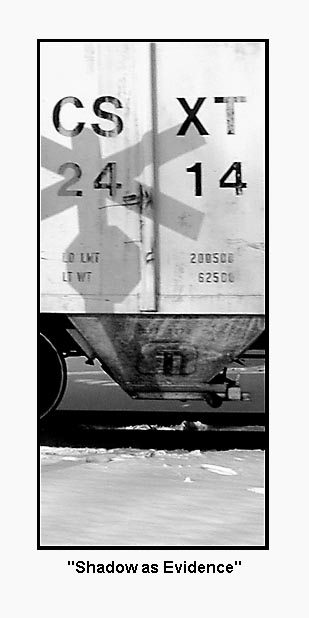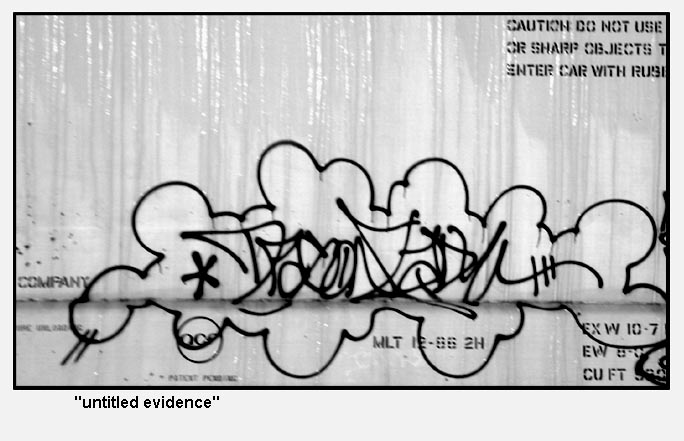Updated 4-2002
EVIDENCE
photography assignment
Assignment Objectives
Learn about the uniqueness of photography among art
forms. What is best done with a photograph rather than a drawing or a sculpture?
A photograph is evidence. We believe it represents something real. We see
it as a true story. Other art forms are less reality based and more metaphorical.
They make references to reality, but we know many art forms themselves
are fabrications. While we know that a photo can be fabricated, we expect
a photograph to be a record of reality.
|

|
What is an
evidence photograph?
When is it ART?
|
memory
truth
documentation
testimony
verification
confirmation
proof
|
Hand In One of the Following
-
One 11 x 14 mounted or matted silver print
-
A series 4 or more 5 x 7 silver prints on one mount
-
The equivalent of either of the above printed with the
11 x 17 black and white printer set to 1200 resolution printed as large
as possible. If you have color information from digital or color
film, make a black and white as well as a color print as large as
possible with the color laser.
-
If working digitally, you may create the final product
as a montage of layers in Photoshop.
Assignment Content
-
Basic assignment: Use photography to show evidence of
people. Make images with meaning about the cause of the images. Work within
a theme. Use any theme based on evidence.
Examples:
Evidence that people don't (or do) care.
Tracks.
Shadows without objects.
Make a list of ideas and themes for yourself and
select the one you like.
-
Advanced assignment (optional substitute for basic assignment):
Make images to show evidence of self. Work within a theme.
THE ARTISTIC QUALITY OF THE ASSIGNMENT
-
Play around and experiment.
-
Create impact.
-
Isolate (with connections).
-
Use a point of view. Have an attitude.
-
Contrast content and ideas within the composition for
emphasis.
-
Hit the viewer in the gut. Produce emotion.
-
Elicit response. Be unpredictable.
THE DESIGN QUALITIES OF THE ASSIGNMENT
-
Use the viewfinder to experiment with framing.
Move up, down, closer, and around.
-
Exploit or eliminate background.
-
Develop a theme with variation. Use repetition with
change.
-
Study the action of the lines and edges.
a. diagonal vs rectilinear
b. curved vs straight
c. jagged vs smooth
-
Move camera to get tonal interchange. Important shapes
have strong contrast with background tone.
-
Study the edges of the viewfinder. Consider the spacing
created by lines as they exit the frame.
AS A PHOTOGRAPHER
-
Play around. Experiment.
-
Make it sharp. Think camera support, film speed, and
lighting.
-
Consider bracketing depth of field.
-
Consider bracketing exposure.
AS A PRINTER
-
Make contacts and discuss them with creative colleagues.
Bounce around some ideas.
-
Print several test prints.
-
Make and mount one or more final prints any shape as
large as possible on 11 x14 paper. If it is cropped square make it 10 x
10. If it is vertical or horizontal it can be anything from 11 x 10 to
13 x 4 or wider.
-
Optionally, you may print and present a series of images.
In some cases a serial format makes a stronger statement.
AS A PRESENTER
-
Retouch the print.
-
Mount on neutral tone such as white, black or gray.
-
Calculate equal margins on sides and top with a larger
margin at bottom. Be generous with margin size.
-
Leave no smudges or marks to distract.
-
Sign with pencil on mount or ink on print without distracting
from the overall presentation.
LINKS to RELATED Goshen College PAGES
Syllabus
for Art 315: Photography
Assignments
page for Art 315: Photography has list of other assignments
Other
photo Assignments linked to Art 255
Other instruction
helps linked to Art 255
Assignment
list
from John Blosser's Art 255 page
LINKS to RELATED WWW PAGES
Lynchings
in America An exhibition of postcard photographs showing evidence
of tragic truths in American history. Part of the B. Davis Schwatz
Memorial Library, C. W. Post Campus, Long Island University, N.Y.
The foundation
remains photograph of Japanese internment facilities
during WWII in America. The
story. A Santa Clara
University site.
Gordon
Parks photos of his experiences as an African American photographer.
A Library of Congress photo archive page, U.S. Government.
http://www.crimescene.com/
All rights reserved. © Marvin Bartel,
instructor. 1998, 2000, 2002.
None
of these materials may be published or copied in any form without prior
permission from the author. Goshen Photography students have permission
to print a personal copy. Others may request authorization by sending
e-mail to: marvinpb@goshen.edu

|
